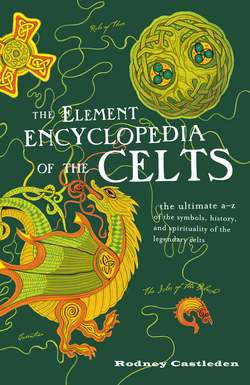Читать книгу The Element Encyclopedia of the Celts - Rodney Castleden - Страница 219
PATRICK
ОглавлениеSt. Patrick, patron saint of Ireland, was probably born in South Wales. His father was a Romano-British deacon named Calpurnius, and his own Celtic name was Succat.
According to legend, Patrick was abducted as a 16-year-old boy by Irish slave traders in about 405 or 410 and carried off to Ireland. He was sold in County Antrim to a chief called Milchu. He managed to escape after six years of captivity and made his way 200 miles overland to board ship. He was at sea for three days, then made his way home to his parents. They urged him never to leave again, but a deep restlessness inspired dreams that made him travel to Rome. He became a monk in Gaul, first at Tours, then at Lerins, before returning to convert his captors. According to Patrick himself, he had decided a long time before that he would have to return to Ireland.
Patrick was consecrated a bishop at the age of 45. In 432 he is believed to have been sent by Pope Celestine I to Ireland as a missionary. He landed at Wicklow and from there sailed north to convert his former master Milchu. In Down he was able to convert another chief, Dichu, to Christianity, and at Tara he preached to Loegaire, King of Tara. He also converted the tyrannous Mac Cuil, who became bishop of the Isle of Man.
After 20 years of missionary work, Patrick fixed his see at the royal center of Armagh, close to the ancient capital of Emain Macha, in 454. He died at Saul in 459 and was probably buried at Armagh.
As a slave himself, Patrick had the strongest personal motive for preaching against slavery. He preached from experience. In an open letter probably written in 445, he censured King Coroticus (Ceretic) of Clyde for stealing Irishwomen and selling them to the Picts as slaves. King Coroticus was not only a pagan, he was a committed anti-Christian. According to Patrick’s hagiographer, Patrick turned him into a fox.
In the 450s, Patrick came into conflict with the wizards of King Loegaire, son of Niall, at Tara (See Magicians). Murchu describes the trial of strength:
The fierce heathen emperor of the barbarians reigned in Tara, the Irish capital. His name was Loegaire, son of Niall. He had wise men, wizards, soothsayers, enchanters and inventors of every black art who were also in their heathen, idolatrous way to know and foresee everything that happened. Two of them were above the rest, their names being Lothroch and Lucetmael.
They predicted that a strange new and troublesome faith would come and overthrow kingdoms.
A pagan festival, Beltane, coincided with Patrick’s celebration of Easter. On the eve of Beltane when a great sacred bonfire was lit, a fire was seen to be burning in the direction of Tara: the religious focus of Ireland. This was surprising, as only the magi were authorized to kindle such a fire. They anxiously approached the blaze and found Patrick and his followers chanting psalms round their campfire.
Patrick was summoned to the Assembly at Tara, where he eloquently defended his mission. The magi challenged him to perform a miracle to prove divine support, but he refused. The magi then cast a spell and blanketed the landscape in heavy snow. Patrick made the sign of the cross and the illusion evaporated.
All kinds of magic feats were performed during this contest between Patrick’s white magic and Lothroch’s black arts. At one point Patrick caused one of the magicians to rise up into the air, fall headlong, and brain himself on a rock.
A great deal has been written about Patrick but his only certain literary remains are his spiritual autobiography, called Confession, and the letter he wrote to Coroticus. The point of his Confession was to explain why he would not return to Britain. The implication is that a British synod claimed authority over him and summoned him in order to exert that authority. Patrick implies that he could override the wishes of the British synod, and he evidently had Pope Leo’s (440–61) approval to support him.
In spite of his high profile, Patrick did not have any obvious successor and in the years following his death he was seen in Ireland as just one saint among many.
